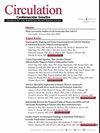Is Left Ventricular Noncompaction a Trait, Phenotype, or Disease? The Evidence Points to Phenotype.
引用次数: 16
Abstract
The question is is left ventricular noncompaction (LVNC) a trait, phenotype, or disease? By trait, we refer to a discrete and measurable characteristic like eye color. The term phenotype expands this definition to include multiple observable traits derived from diverse genetic factors (genotype) and to recognize additional roles for the environment in shaping visible expression of a genetically defined trait. Pathological phenotypes, with their myriad signs, symptoms, diagnoses, and prognoses, are recognized as diseases and are most often associated with adverse clinical manifestations or need for medical or surgical intervention. See Article by Miller et al So where in this conceptual framework do we place LVNC? This is a well-debated topic1,2 and one that has been recently systematically and expertly reviewed in much greater depth than afforded by this editorial.1–4 Although LVNC has increasingly been recognized as a cardiomyopathy5—itself a term with clear disease connotations—mounting evidence now points to reclassification of LVNC as a distinct but not necessarily pathological phenotype. More specifically, the degree of compacted to noncompacted (NC) myocardium, by itself alone, does not seem to cause disease. Why phenotype rather than trait? Traits are considered to be genetically driven and not malleable by the environment. As defined above, genetics interacting with environment are best labeled as phenotype. Left ventricular (LV) morphology is not fixed for certain characteristics, including LV wall thickness or LV size. The former is well known to increase with severe hypertension or aortic stenosis, and the latter increases with volume overload from aortic insufficiency. With medical or surgical therapy, both conditions will regress. A similar paradigm has been observed with dilated cardiomyopathy—a disease phenotype associated with heart failure and arrhythmia for which the dilated or remodeled left ventricle will reverse remodel with appropriate medical therapy. Characteristics such …左心室非压实是一种特征、表型还是疾病?证据指向表型。
本文章由计算机程序翻译,如有差异,请以英文原文为准。
求助全文
约1分钟内获得全文
求助全文
来源期刊

Circulation: Cardiovascular Genetics
CARDIAC & CARDIOVASCULAR SYSTEMS-GENETICS & HEREDITY
自引率
0.00%
发文量
0
审稿时长
6-12 weeks
期刊介绍:
Circulation: Genomic and Precision Medicine considers all types of original research articles, including studies conducted in human subjects, laboratory animals, in vitro, and in silico. Articles may include investigations of: clinical genetics as applied to the diagnosis and management of monogenic or oligogenic cardiovascular disorders; the molecular basis of complex cardiovascular disorders, including genome-wide association studies, exome and genome sequencing-based association studies, coding variant association studies, genetic linkage studies, epigenomics, transcriptomics, proteomics, metabolomics, and metagenomics; integration of electronic health record data or patient-generated data with any of the aforementioned approaches, including phenome-wide association studies, or with environmental or lifestyle factors; pharmacogenomics; regulation of gene expression; gene therapy and therapeutic genomic editing; systems biology approaches to the diagnosis and management of cardiovascular disorders; novel methods to perform any of the aforementioned studies; and novel applications of precision medicine. Above all, we seek studies with relevance to human cardiovascular biology and disease.
 求助内容:
求助内容: 应助结果提醒方式:
应助结果提醒方式:


